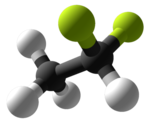| |||

| |||
| Names | |||
|---|---|---|---|
| Preferred IUPAC name
1,1-Difluoroethane | |||
Other names
| |||
| Identifiers | |||
3D model (JSmol)
|
|||
| ChEMBL | |||
| ChemSpider | |||
| ECHA InfoCard | 100.000.788 | ||
PubChem CID
|
|||
| RTECS number |
| ||
| UNII | |||
CompTox Dashboard (EPA)
|
|||
| |||
| |||
| Properties | |||
| C2H4F2 | |||
| Molar mass | 66.05 g/mol | ||
| Density | 900 g/L @ 25 °C | ||
| Melting point | −117 °C (−179 °F; 156 K) | ||
| Boiling point | −24.7 °C (−12.5 °F; 248.5 K) | ||
| Critical point (T, P) | 113.45 °C | ||
| 0.54% @ 0 °C | |||
| Vapor pressure |
| ||
| Viscosity | 8.87 μPa·s (0.00887 cP) @ 25 °C | ||
| Hazards | |||
| Occupational safety and health (OHS/OSH): | |||
Main hazards
|
Extremely flammable | ||
| GHS labelling: | |||

| |||
| Danger | |||
| NFPA 704 (fire diamond) | |||
| Safety data sheet (SDS) | SDS for 1,1-difluoroethane | ||
Except where otherwise noted, data are given for materials in their standard state (at 25 °C [77 °F], 100 kPa).
| |||
1,1-Difluoroethane, or DFE, is an organofluorine compound with the chemical formula C2H4F2. This colorless gas is used as a refrigerant, where it is often listed as R-152a (refrigerant-152a) or HFC-152a (hydrofluorocarbon-152a). It is also used as a propellant for aerosol sprays and in gas duster products. As an alternative to chlorofluorocarbons, it has an ozone depletion potential of zero, a lower global warming potential (124) and a shorter atmospheric lifetime (1.4 years).[2][3]
- ^ 1,1-Difluoroethane at Sigma-Aldrich
- ^ "Changes in Atmospheric Constituents and in Radiative Forcing" (PDF). Cambridge University Press. 2007. p. 212. Retrieved 11 May 2017. 18 February 2019
- ^ "Global Warming Potentials of ODS Substitutes". U.S. Environmental Protection Agency. 2010. Archived from the original on 16 October 2010. Retrieved 20 September 2010.


